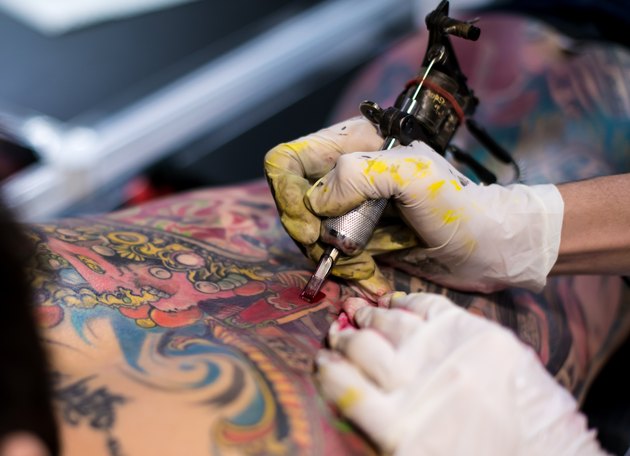Overview Tattooing has been around since ancient times. Today, the Mayo Clinic reports that as many as 20 million Americans are tattooed.
Permanent tattoos are applied by injecting color pigments (the same color additives used in cosmetics which are monitored by the FDA) into the skin using a solid, round-tip needle attached to a motorized instrument that holds up to 14 needles attached to the pigments. Most tattoo artists use an electrically powered, vertical, vibrating instrument to inject the tattoo pigment. The pigments are injected into the middle layer of the skin at a rate of 15 to 3,000 times per minute.
In other cases, tattoo artists apply the tattoo by hand, dipping a needle into pigment without the use of an electric instrument.
Bleeding, pain and some discomfort are to be expected. The intensity of pain from a tattoo depends upon the location and size.
Before You Get a Tattoo A tattoo is forever. If you decide that you want a tattoo, know exactly what you want before you find a studio. After you have decided, you will need to find the right artist to do the work. Choose someone with a good reputation or someone whose work you have seen on your friends or other people.
Remember, just because a tattoo parlor is in business doesn't mean it is maintaining safety and sterility precautions. The Center for Disease Control and Prevention reports that gangrene, syphilis, tuberculosis and HIV are just a few diseases you could contract from contaminated instruments. To avoid these risks, ask to see a state license and accreditation from The Alliance of Professional Tattooing (or a similar organization). Look for basic equipment like germicidal soap, needle buckets, proper disposal containers, packaged gauze with the sterility intact and disposable gloves. The studio should also be equipped with an autoclave, a device that pressurizes instruments and kills viruses or bacteria. Finally, look for single-use or disposable needles (single-use are preferred).
Do not get a tattoo if you are sick or not feeling well. Also, make sure you've had food and rest. Getting tattooed on an empty stomach may cause you to feel faint, nauseated or dizzy. Do NOT take pain killers like aspirin, ibuprofen and anesthetics, which may possibly cause cause problems like increased bleeding.
Do not get tattooed under the influence of drugs or alcohol. It is extremely dangerous for your health and tattoo.
If not properly cared for during the first two weeks, the area has the potential for infection and scarring. Follow these steps to promote a healthy tattoo:
• Remove the bandage after 4 to 12 hours, depending upon the size and location of the tattoo. Do NOT re-bandage. Wash your tattoo with warm water and an antibacterial, unscented soap. Gently pat dry with a clean towel. Apply a thin layer of triple antibiotic ointment or a product designed specifically for tattoo aftercare (Tattoo Goo, H2Ocean and Tat Wax are just a few). • Use the same ointment three or four times per day during the first two days after cleaning the area. Also apply a thin layer of unscented water-based lotion each time (oil-based lotions like Vaseline will burn). Make sure your hands are completely clean before touching the tattoo. Apply the ointment and lotion three to four times daily for the next two to three weeks. • The normal healing time for a tattoo is two to four weeks. Do NOT pick or scratch your tattoo. Flaking or peeling is a natural part of the healing process. • Do not soak your tattoo during healing. That means no baths, hot tubs or pools. • Keep your tattoo out of direct sunlight while it’s healing. • Tattoos do fade over time, so moisturize your skin with lotion to keep the colors fresh.
If you have a tattoo but would like to get rid of it, there are various methods of tattoo removal. The removal method depends upon the pigment used, the amount of time the tattoo was on the skin, size, location and whether or not it was done professionally. It is important to remember that it costs more to remove a tattoo than to apply one and is not covered by most health insurance companies. Finally, total removal of a tattoo is not always possible. Your options for removal include surgical removal, dermabrasion, salabrasion or laser treatment.
Ask Your Physician Please consult a physician at any sign of infection or allergic reaction, and report any infection or allergic reaction to the tattooist and your State Department of Health.
Advertisements

Overview Tattooing has been around since ancient times. Today, the Mayo Clinic reports that as many as 20 million Americans are tattooed.
Permanent tattoos are applied by injecting color pigments (the same color additives used in cosmetics which are monitored by the FDA) into the skin using a solid, round-tip needle attached to a motorized instrument that holds up to 14 needles attached to the pigments. Most tattoo artists use an electrically powered, vertical, vibrating instrument to inject the tattoo pigment. The pigments are injected into the middle layer of the skin at a rate of 15 to 3,000 times per minute.
In other cases, tattoo artists apply the tattoo by hand, dipping a needle into pigment without the use of an electric instrument.
Bleeding, pain and some discomfort are to be expected. The intensity of pain from a tattoo depends upon the location and size.
Before You Get a Tattoo A tattoo is forever. If you decide that you want a tattoo, know exactly what you want before you find a studio. After you have decided, you will need to find the right artist to do the work. Choose someone with a good reputation or someone whose work you have seen on your friends or other people.
Remember, just because a tattoo parlor is in business doesn't mean it is maintaining safety and sterility precautions. The Center for Disease Control and Prevention reports that gangrene, syphilis, tuberculosis and HIV are just a few diseases you could contract from contaminated instruments. To avoid these risks, ask to see a state license and accreditation from The Alliance of Professional Tattooing (or a similar organization). Look for basic equipment like germicidal soap, needle buckets, proper disposal containers, packaged gauze with the sterility intact and disposable gloves. The studio should also be equipped with an autoclave, a device that pressurizes instruments and kills viruses or bacteria. Finally, look for single-use or disposable needles (single-use are preferred).
Do not get a tattoo if you are sick or not feeling well. Also, make sure you've had food and rest. Getting tattooed on an empty stomach may cause you to feel faint, nauseated or dizzy. Do NOT take pain killers like aspirin, ibuprofen and anesthetics, which may possibly cause cause problems like increased bleeding.
Do not get tattooed under the influence of drugs or alcohol. It is extremely dangerous for your health and tattoo.
If not properly cared for during the first two weeks, the area has the potential for infection and scarring. Follow these steps to promote a healthy tattoo:
• Remove the bandage after 4 to 12 hours, depending upon the size and location of the tattoo. Do NOT re-bandage. Wash your tattoo with warm water and an antibacterial, unscented soap. Gently pat dry with a clean towel. Apply a thin layer of triple antibiotic ointment or a product designed specifically for tattoo aftercare (Tattoo Goo, H2Ocean and Tat Wax are just a few). • Use the same ointment three or four times per day during the first two days after cleaning the area. Also apply a thin layer of unscented water-based lotion each time (oil-based lotions like Vaseline will burn). Make sure your hands are completely clean before touching the tattoo. Apply the ointment and lotion three to four times daily for the next two to three weeks. • The normal healing time for a tattoo is two to four weeks. Do NOT pick or scratch your tattoo. Flaking or peeling is a natural part of the healing process. • Do not soak your tattoo during healing. That means no baths, hot tubs or pools. • Keep your tattoo out of direct sunlight while it’s healing. • Tattoos do fade over time, so moisturize your skin with lotion to keep the colors fresh.
If you have a tattoo but would like to get rid of it, there are various methods of tattoo removal. The removal method depends upon the pigment used, the amount of time the tattoo was on the skin, size, location and whether or not it was done professionally. It is important to remember that it costs more to remove a tattoo than to apply one and is not covered by most health insurance companies. Finally, total removal of a tattoo is not always possible. Your options for removal include surgical removal, dermabrasion, salabrasion or laser treatment.
Ask Your Physician Please consult a physician at any sign of infection or allergic reaction, and report any infection or allergic reaction to the tattooist and your State Department of Health.



Comments